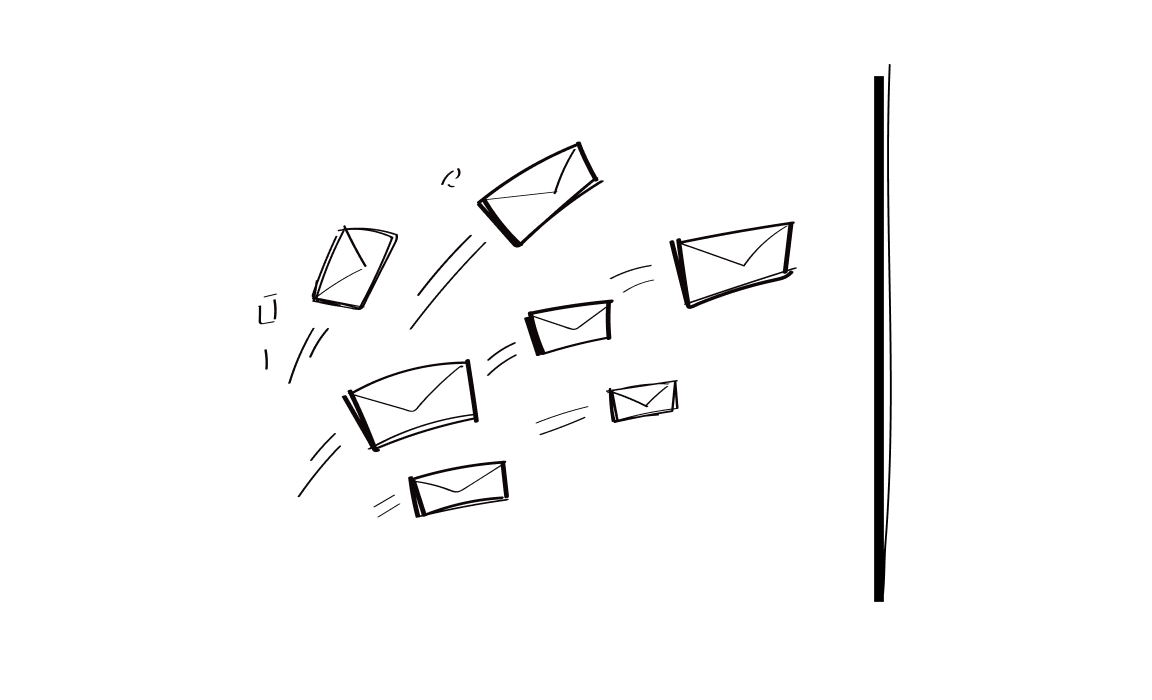Email should be simple. But if your inbox looks more like a mess than a workspace, you’re not alone. That’s where tools like Spark Mail come in, with promises to clean things up and streamline your email marketing efforts.
But is it the right fit for everyone? Or are there better options for people who don’t just want to read emails, but act on them?
In this article, we’ll discuss what Spark does well, where it falls short, and which tools do the job better.
What is Spark Mail?
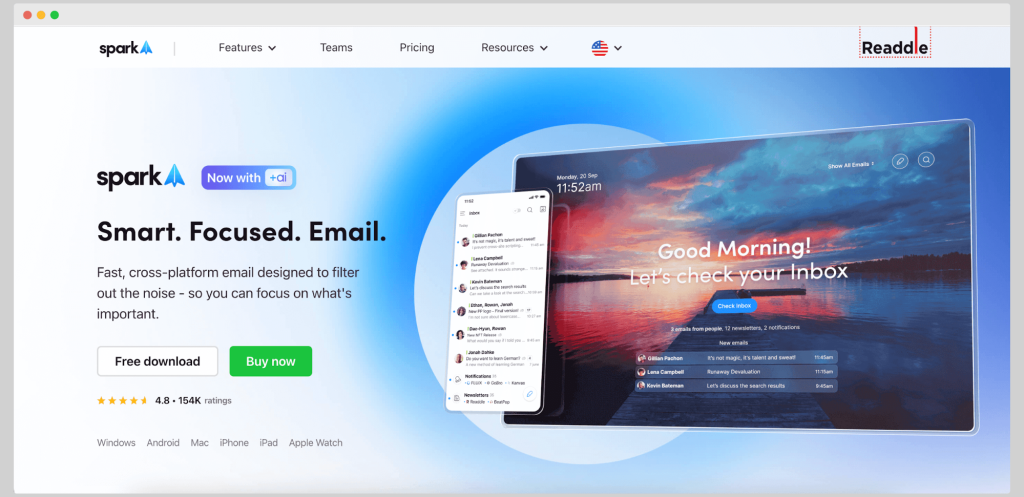
Spark Mail is a cross-platform email app built for people who want better control over their inbox. It’s designed for personal and business emails, providing clients with tools to manage conversations, process messages more efficiently, and focus on what truly matters.
The Spark Mail’s idea is simple: highlight important emails and build better habits around email communication.
If your inbox has ever felt like a never-ending to-do list, Spark promises a smarter experience.
It works across platforms (desktop, phone, even Apple Watch) and is used by individuals, freelancers, and modern teams.
Now, let’s take a closer look at what this mail app does.
Spark Mail key features: not only multiple email accounts
You might have heard people say Spark is good because it connects all your email accounts in one place. That’s true – you can connect Gmail, Outlook, Yahoo, iCloud, and more into one inbox. But that’s just a part of the story.
Let’s break down a few of the most useful things Spark can do.
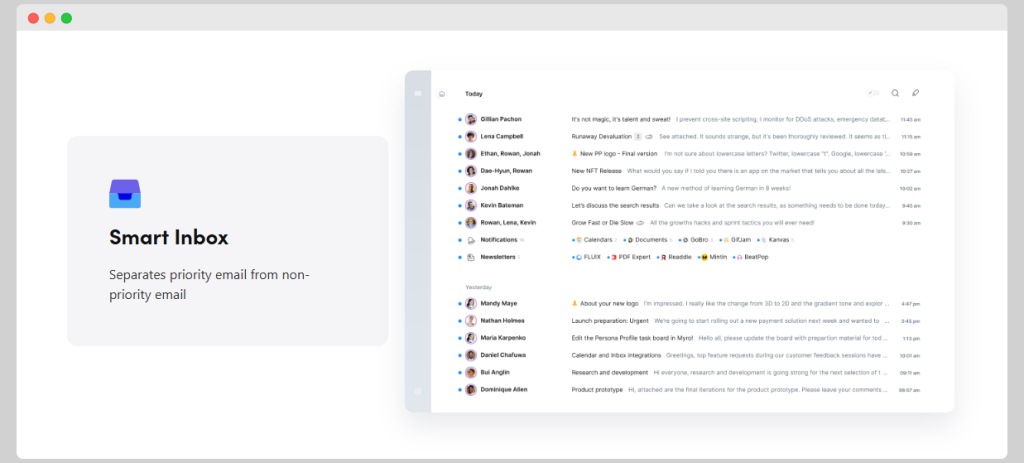
- Smart inbox: Instead of one long list of emails, Spark’s smart inbox sorts your messages into categories like newsletters, notifications, and real conversations.
- Group by sender: It groups emails by who sent them. That means all your updates from a specific client or teammate get bundled up nicely.
- Gatekeeper & Block senders: Before emails land in your inbox, you can screen them. Spark helps you pre-screen and block unwanted senders entirely.
- Shared drafts: You can collaborate on emails in real-time, like editing a Google Doc. It’s good for polishing up those high-priority business emails together.
- Shared inboxes: You can assign emails, leave internal comments, and track progress without external tools.
- Command center for desktop: These are options for your inbox, packed with shortcuts and quick actions to mark tasks, snooze emails, or jump between specific emails fast.
- Sync between devices: Use Spark on desktop, phone, or tablet. Everything stays in sync, thanks to its cross-platform email designed for consistency.
There’s more, like calendars, reminders, mute threads, and secure links for sharing emails.
However, there’s also something new in the mix.
Spark +AI email assistant
Like many other email service providers, Spark Mail added AI email options to its stack. Fortunately, it doesn’t train its AI on your private email content; it says it’s private by design.
Here’s what you get with Spark +AI*:
- Compose with AI: Give Spark some context, and it’ll try to help write emails faster, using your tone and voice.
- Quick AI reply: These are pre-filled responses that you can tweak and send. It’s good for when you want to reply fast but not sound like a robot.
- Edit: Spark AI can check grammar, fix the tone,and expand or shorten your text. Pretty standard for AI tools today.
- +AI Summary: Spark can summarize emails for you in different styles – short, detailed, or by action points.
- + AI Translate: Now you can translate drafts or received emails inside the app.
*Worth noting: +AI features live inside Spark Premium, and they come with a usage quota. Thus, you’re not getting unlimited smart replies.
They’re nice features, but for more advanced email automation, cold outreach, and email follow-ups, you might still want a more tailored mail app – one that provides you with tools built specifically for outreach and email communication.
Spark Mail pricing
Spark Mail has three pricing tiers:
- Free Basic plan (€0/month)
- Premium Individual plan (€5.83/month, billed annually),
- Premium Teams plan (€6.99 per user/month, billed annually, no VAT included).
What does that mean in practice?
Basic plan
If you’re using Spark Basic, you’ll get a decent setup. You can connect multiple accounts, access smart inbox, sync across devices, and use core tools like reminders, snooze, and send later.
But you’re missing out on the good stuff like priority emails, group by sender, and the AI features.
Premium Individual plan
With Spark Premium, you block unwanted senders, mute threads, priority emails, and use the home screen for desktop. You’ll also get full access to Spark’s AI assistant.
Premium Teams plan
Then there’s the Premium Teams plan. It’s built for teams that want to collaborate directly in their inboxes. You get unlimited assignments, shared templates, and tools to track progress, set deadlines, and manage team members. It even lets you store files (10 GB per team member) and manage team roles.
Collaboration features, such as a real-time editor for shared drafts and inviting teammates to work on emails together, are also included.
However, even in the top-tier plan, AI usage is limited by quota, not unlimited, as you might assume.
What do users have to say about Spark?
Spark Mail has an average score of 3.5 out of 5 stars on G2, which indicates that users are clearly divided.
Some of them mentioned positive customer support and how easy it is to train new members. One person even called it the “best free email app” they’ve used, highlighting how Smart Read helps them fly through newsletters and specific emails without missing the important ones.
Others mention how smooth it is to get started, which makes it a handy email client tool for people with no technical skills.
However, people see that the AI features are locked behind a paywall, which feels limiting if you’re on the free plan. Another client said the platform struggles with real-time email updates—describing it as micro-batching, which doesn’t really cut it for fast-moving teams. So, if your team runs on up-to-the-second updates, that might be a red flag.
Yes, one review noted that the setup was quick. But after that? They ran into connection issues, bugs, and inconsistent alerts. To the point that their team eventually gave up and stopped using it altogether.
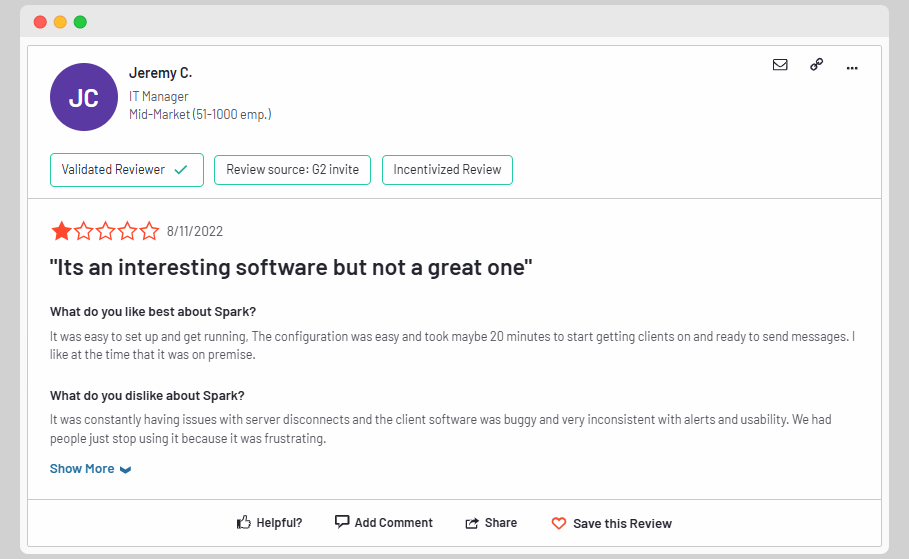
While Spark’s visual features, such as boards and graphs, received a thumbs-up from one user, another felt it lacked depth compared to other apps.
Are there better alternatives to Spark Mail?
At first glance, Spark Mail looks sleek. It helps you organize emails and clean up distractions, which is great… if you’re managing inbound email.
But what if you’re trying to send cold emails, follow up automatically, and actually convert leads? Then Woodpecker is a better choice.
Woodpecker: spark teams with this comprehensive tool
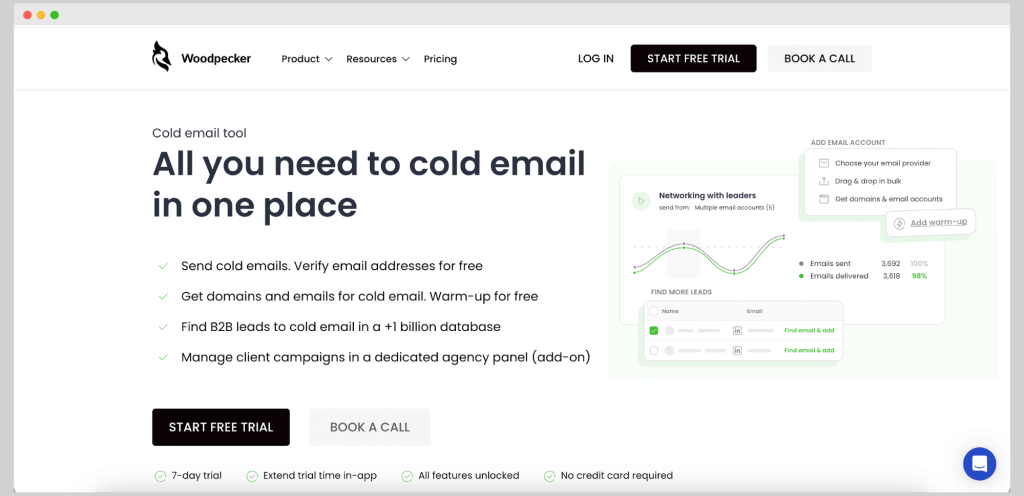
Woodpecker is a sales and outreach platform. You don’t just read and reply, you create cold email sequences that send themselves, follow up based on recipient behavior, and track replies across your campaigns.
Imagine sending 1-on-1 emails to 100 prospects, each with custom intro lines and follow-ups, and getting real-time updates on who opened, clicked, replied, or ignored you. That’s Woodpecker.
Woodpecker key features:
- Free warm-up – your emails need warming up to avoid spam. Woodpecker does it automatically.
- Inbox rotation – send from multiple email accounts without tripping spam filters.
- Centralized inbox – handle replies from different inboxes in one place (like Spark’s unified inbox—but smarter).
- Deliverability monitor – keeps an eye on how your emails are doing. Spark doesn’t give you that level of feedback.
- Condition-based campaigns – set paths depending on how someone reacts (or doesn’t).
- Workflows – build out email sequences with custom logic, not just one-and-done sends.
- A/B testing – see what works best, without guessing.
- AI interest detection – automatically spots if someone sounds curious or not.
- Snippets & conditions – insert dynamic content based on recipient data.
- Integrations – connect to HubSpot, Pipedrive, Zoho, Calendly, Zapier, Google Sheets, and more.
Woodpecker pricing
Woodpecker’s pricing starts at $0 for a 7-day free trial. Next, there is $20/month (billed annually) for the Starter plan, which covers up to 500 prospects and includes email support.
The Growth plan, at $126/month, is the most popular. It scales up to 10,000 prospects and offers 20 free warm-ups. For teams with bigger needs, Scale ($903/month) and Max ($6,666/month) unlock massive outreach capacity, unlimited contacts, and premium support options.
Mailbutler: add productivity to your smart inbox
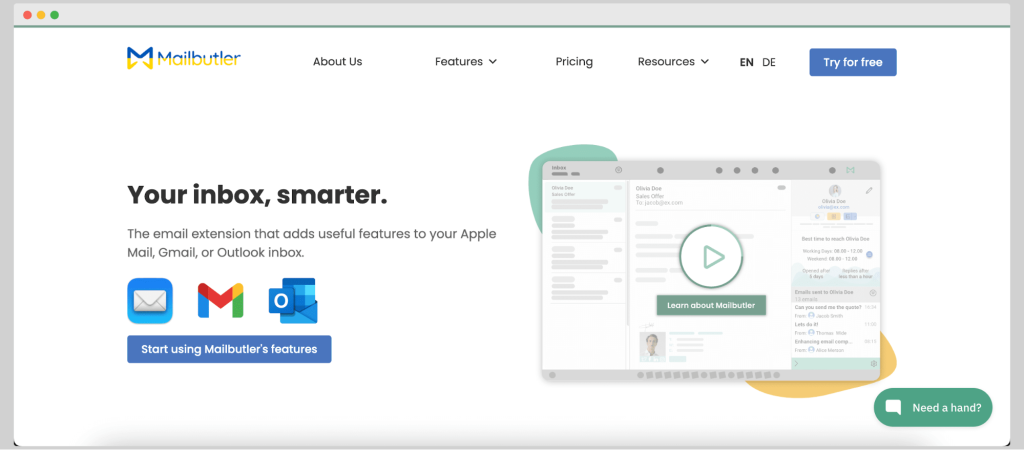
Mailbutler is an email extension that adds useful features to your inbox, such as Gmail, Apple Mail, or Outlook. It brings in productivity tools like email tracking, send later, notes, and task management, all without switching apps. You can also create email templates, schedule follow-ups, and get insights on your outreach — right inside your favorite email client.
Mailbutler key features
- Email tracking
- Email templates
- Tasks, tags, notes
- Collaborators
- Smart send later
- Smart assistant
- Shared inbox collaboration
Mailbutler pricing
Four plans are available.
Tracking starts at $3.95 per user per month, providing open and link tracking, as well as email tags. Professional is $7.95 per user per month and gives you everything in Tracking + more, like contact management.
The Smart plan is $12.95 per user per month and includes everything in Professional plus more, such as an AI-powered email assistant. The Business plan is $29.95 per user per month and includes everything from the previous plans, plus benefits like priority customer support.
MailMeteor: run simple outreach campaigns from mail apps

MailMeteor is an email marketing tool that lets businesses send out personalized cold outreach emails through Gmail and Outlook. It’s built for simplicity, letting you personalize each message with merge tags and track opens or clicks in real time. You can also use AI to generate responses and manage campaigns directly from Google Sheets.
MailMeteor key features
- Mass email campaigns directly out of Gmail or Outlook
- Scheduled sending
- Email deliverability features
- AI-based personalization
- Scheduled follow-ups
MailMeteor pricing
There are four plans: Premium, Pro, Business, and Free.
Premium is $9.99 per user per month and lets you send up to 15,000 emails monthly. Pro is $24.99 per user per month and is good for 45,000 monthly emails. The Business plan is $49.99 per month and allows for 60,000 emails monthly. The Free plan gives you 50 emails daily.
Focus on what’s important with Woodpecker
Spark Mail has some smart features. Its clean interface, AI tools, and group email functions are nice, but it stops short when you need deeper control, outreach automation, or real collaboration around email communication.
If your goal is to clean emails and reply faster, Spark might be enough. But if you’re ready to send smarter and actually track progress across real conversations, tools like Woodpecker bring more to the table.
Each of them speaks to a different kind of workflow.
Spark keeps it tidy. Woodpecker helps you grow.
You decide which inbox future you’re building toward.

